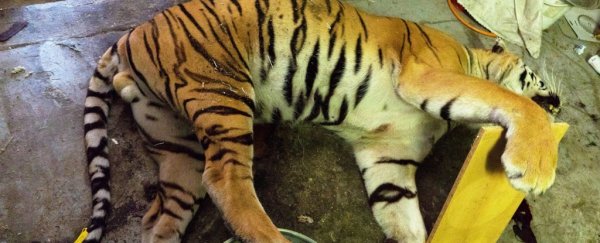A five-year long investigation into the criminal trade of tiger parts in Czechia culminated in the discovery of a horrific animal slaughterhouse in Prague, and shows illegal trafficking in big cats isn't just a problem in Asia.
Back in July, inspectors with the Czech Environmental Inspectorate (CEI) led over 200 police and customs officers in Operation Trophy: a raid of 10 premises in Prague and the Bohemian region. Tragically, what they found inside wasn't for the faint-hearted (warning: we've included some distressing photos below).
In one facility, sprawled on the floor, lay a freshly killed four-year-old tiger, with an eye missing and a weeping bullet wound on its neck. An autopsy showed it had been shot in the throat, so its valuable pelt would be spared.
 (CEI)
(CEI)
This, inspectors say, is the face of a recently discovered criminal enterprise operating in Czechia and potentially elsewhere across Europe: tigers that are illegally farmed and slaughtered for their organs, which fetch high prices on the black market as traditional Chinese medicines once extracted, prepared, and exported to Asia.
"We have been warning for several years that illegal trade in tiger products is [a] really serious problem in Europe, not only in Asia," says lead CEI inspector Pavla Říhová.
"There are many tigers in captivity in Europe, a lack of overview who holds them and where."
In a report compiled for members of the Convention on International Trade in Endangered Species of Wild Fauna and Flora (CITES) who met in Russia last month, investigators detail how an increase in seizures of tiger body parts and tiger products in Czechia since 2013 led to the discovery of an international crime network that sells slaughtered animals piece by piece to buyers in Vietnam.
Before they uncovered the slaughterhouse this year, a trail of evidence slowly revealed the extent of the operations.
In 2013, a man was found with almost 8 kilograms of tiger bones in a black garbage bag – a complete skeleton, but composed of the intermingled remains of two separate individuals.
 (CEI)
(CEI)
Later seizures consisted of other bones concealed in stereo loudspeakers, various teeth and claws (including an ornate tiger tooth pendant), plus various powders, fluids, and broth ingredients (including stock cubes called bouillon cubes) - all sourced from tigers.
According to the report, up to 10 kilograms of tiger stock can be made from a single animal, and sells for almost US$70 per gram due to traditional cultural beliefs about its supposed healing properties. Meanwhile, tiger claws go for about US$115.
Live specimens, bred for petting zoos and circuses (if not their parts), fetch much more, selling for over US$25,000 each, according to animal welfare organisation Four Paws.
"The belief that tigers from Europe are bigger and stronger is widespread in Asia," says the group's head of wildlife campaigns, Kieran Harkin.
"It is similar to cars – the European origin stands for quality. Asian wildlife traders openly say that they and their customers prefer Euro-Tigers."
 (CEI)
(CEI)
What Operation Trophy found when they raided the Prague factory behind this gruesome product chain was enough to shock even investigators who have been researching such cases for decades.
"I have been working for the inspectorate 25 years … but the situation there was really horrible," Říhová told The Guardian.
"If you can imagine: an old freezer, without electricity, full of meat and dead bodies, in the garden for two years. Absolutely incredible."
Beside the dead tiger in the facility, inspectors found a number of tigers in varying states of decomposition (and cougar skins), along with 'processor' equipment: a boiling pot used to reduce the animals' bones to bouillon, plus hanging claws, electric saws, and other cooking items.
Animals were bred at another premises, kept in filthy, concrete cubicles and cages.
As gruesome as these slaughterhouse operations are, it's even more horrific when you consider that less than 4,000 tigers remain in the wild, although recent conservation efforts have enjoyed at least some success.
As the report outlines, the threat of exploitation like this is mostly reserved for captive, not wild, animals, but it nonetheless stimulates demand in the black market for illegal tiger products, helping create a "situation [that] certainly does not contribute to the protection of the remaining wild populations of tigers".
And, with tiger numbers so perilously low – and China flip-flopping on bans of sales of animal parts – these animals need all the protection they can get.
